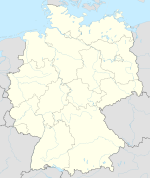Zwickau toboggan run
| Zwickau luge track | |||||||||||||||||||||||||
|---|---|---|---|---|---|---|---|---|---|---|---|---|---|---|---|---|---|---|---|---|---|---|---|---|---|

|
|
||||||||||||||||||||||||
| Plan of the train | |||||||||||||||||||||||||
| place |
|
||||||||||||||||||||||||
| owner | City of Zwickau | ||||||||||||||||||||||||
| operator | ESV Lokomotive Zwickau eV | ||||||||||||||||||||||||
| Installation | October 6, 1979 | ||||||||||||||||||||||||
|
|||||||||||||||||||||||||
Coordinates: 50 ° 41 ′ 45.9 ″ N , 12 ° 29 ′ 14.5 ″ E
The Zwickau toboggan run is the world's first plastic racing toboggan run for the sport of luge . The toboggan run is located in Germany in Zwickau at the Westsachsenstadion on the disused mining dump of the Vereinsglückschacht. 7 curves extend over a total length of 370 m, with modern sledges maximum speeds of up to 90 km / h are possible.
The track was built from 1975 to 1979 with the help of Karl Zenker's commitment and has been used for children's and youth sports in the Zwickau region ever since. Numerous luge talents such as Chris Eißler , Cathleen Martini , Ute Rührold , Bernd and Ulrich Hahn , Petra Tierlich and Michael Walter trained on it . The runway was extensively renovated in 2004 and got a new surface. In 2019, a curve was added at the finish in order to lengthen the run and thus take modern sledges into account.
Location and surroundings
The railway area is a bit hidden to the left above the Westsachsenstadion on the southern slope of the heap.
Construction and data
The material used was glass fiber reinforced polyester resin , which was processed using two methods. Sometimes there was a lamination of the track parts to support stands, partly negative forms were used. The accuracy could be set to plus / minus 2 mm.
- The track sections are between 2.5 m and 5 m long and the curves have radii between 10 m and 29 m.
- The total length is 370 m on 7 curves and the time can be measured on up to 300 m and 6 curves.
- The measurement accuracy is 1/1000 s.
- The average gradient is 13.2%.
- The maximum height difference is 16 m.
History of origin
In 1975 the planning of the toboggan run began by the company WTZ Sportbauten Leipzig. A draft of the track with five curves emerged from their planning; today's curve one was only added later in the course of the planning. The track pieces were manufactured in what was then RAW Zwickau. In 1977 the construction of the railway could begin, this was carried out by trainers, a sponsor brigade of the Reichsbahnausbesserungswerk (RAW) “7. Okober ”and numerous volunteers. On October 6, 1979, the toboggan run was opened and handed over to the association. During the first driving tests it turned out that the sledges that had been used up until then were unusable. A new type of sled was developed for this with many small hard plastic rollers, the so-called "millipedes".
use
The track is a plastic toboggan run for summer operation. In the past, the rink could be used as a natural ice rink even in winter if the low temperatures were long enough. Unfortunately, this is no longer possible today due to the consistently warm weather conditions. The young talents of tobogganing from the region are spotted and encouraged on the toboggan run. Particularly good athletes make the step to Saxon Olympic bases such as the Olympic base in Oberwiesenthal and up to the national team.
The toboggan run is also available for training by foreign toboggan associations. Schools, after-school care centers and other groups of children also use the train regularly. The use of the train by adults for various occasions such as celebrations or anniversaries is enjoying increasing popularity.
Launch system
Between 1999 and 2000, next to the Zwickau toboggan run, an iceable starting facility with a total length of 36 m was built on the site of the sports facility. The starting system has a cooling system with an output of 8 kW, so that the starting system can freeze even when the temperature is above zero. This allows the athletes a longer and more effective preparation phase for the winter months and the associated competitions. Training on ice is important because the behavior of sleds on ice differs significantly from starting with a summer sled.
Karl Zenker Monument
Karl Zenker's memorial is in the finish curve and was dedicated to the deceased Chairman of the Sports Commission of the International Luge Federation (FIL) and co-initiator of the track construction in Zwickau. The monument was erected in honor of his life's work and has the motto "Zenker - Zwickau - Goals - Future".
literature
Web links
- Website of the Zwickau toboggan run
- Website of the ESV Lok Zwickau e. V.
- FIL Summer Cup website
- Video of the departure
Individual evidence
- ↑ Toboggan park - data website of the toboggan run Zwickau. Retrieved May 27, 2020.
- ↑ Zwickau toboggan run is being renewed In: BLICK , July 27, 2019 (awo)
- ↑ Railway construction website for the Zwickau toboggan run. Retrieved May 27, 2020.
- ↑ Railway construction website for the Zwickau toboggan run. Retrieved May 27, 2020.
- ↑ Guest tobogganing website of the Zwickau toboggan run. Retrieved May 27, 2020.
- ↑ Railway construction website for the Zwickau toboggan run. Retrieved May 27, 2020.
- ↑ FIL executive meets in Zwickau Website of the FIL - Luge Organization. Retrieved May 27, 2020.


